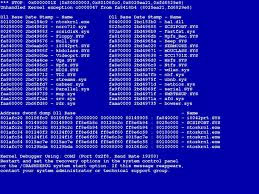Blue Screen of Death - An Enhanced Outlook
Tuesday, September 6, 2011
Users of windows system are sure to have experienced, at one point or another, the terrors of "The Fatal Exception", commonly called the "Blue Screen Of Death", or BSOD. Although the BSOD has largely been thrown onto the software slag heap, in Vista, crashes haven't been totally banished. When windows encounters a condition that compromises safe system operation (i.e. a "bug"), the system halts. This condition is called a 'bug check'. It is also commonly referred to as a system crash, a kernel error, a system fault, or a Stop error. When Windows encounters such a serious error that forces it to stop running, it displays a BLUE SCREEN OF DEATH or just 'lovingly' called BSOD!
In Vista (and Windows 7), unlike XP, where the system was essentially manual, the Windows Error Reporting has been improved & streamlined. and improved in Windows 7 & Vista. One had to follow-up to see if a solution had become available. This was a rather painful process! In Vista / 7, this entire reporting and follow-up process is automated.
These days a Vista / 7 user is more often likely to see a message as follows: "Microsoft Windows Operating System is not responding." And users are given two possibilities. They can either "Close the program" or "Wait for the program to respond." One waits in the hope that the issue will be resolved; or else then one just closes the program and gets prepared to lose information. Atleast, these messages look less daunting.
The BSODs on the other hand were/are quite traumatic and frustrating, to say the least!
The exact text of a Stop error varies, according to what caused the error. But the format is standardized and is made up of 3 parts:
PART 1.
Symbolic error name: This is the Stop Error message that is given to the OS and corresponds to the Stop Error number that appears.
PART 2.
Troubleshooting recommendations: This text applies to all Stop Errors of that particular type.
PART 3.
Error number and parameters: Its the bugcheck information. The text following the word STOP includes the error number, in hexadecimal notation, and up to four parameters that are typical of this error type.
Here are some computer tips to handle the BSOD.
First & Foremost, see if a System Restore or Last Known Good Configuration is able to resolve this issue. Else, then run your ant-virus and anti-spyware and your PC Junk/Registry Cleaner. After this, Run the Windows Check Disk Utility. Then try to identify if you've made any software or hardware change or modification.
In most cases, software is the victim and not the cause of BSOD's. So don't rule out hardware problems. It could be damaged hard disks, defective physical RAM, overheated CPU chips or anything else!
Check if you can see a driver name in the error details. If you can, then simply disabling, removing, or rolling back that driver to an earlier version can help solve that problem. Network interface cards, disk controllers and Video Adapters are the culprits, most often.
Check your memory. Use Vista's Memory Diagnostic Tool. Go to Control Panel and type "memory" in the Search box. Under Administrative Tools, click Diagnose Your Computer's Memory Problems. In the Windows Memory Diagnostics Tool, shown here, select one of the options.
Check your system BIOS carefully Is an update available from the manufacturer of the system or motherboard? Check the BIOS documentation carefully; resetting all BIOS options to their defaults can sometimes resolve an issue caused by over tweaking.
Check if you are you low on system resources? Sometimes a critical shortage of Disk Space or RAM can cause BSOD's. Check if system file has been damaged? Work in Safe Mode, as only the core drivers and services are activated. If your system starts in Safe Mode but not normally, you very likely have a problem driver. Try running Device Manager in Safe Mode and uninstalling the most likely suspect. Or run System Restore in Safe Mode.
Read more: http://goo.gl/OEISl
Related Post :-
Solutions To Outlook Express Errors
Fix POP3_RESPONSE_ERROR
Recognizing the Outlook Express Error
OL98: Invalid Response Error Received When Retrieving Mail




0 comments:
Post a Comment